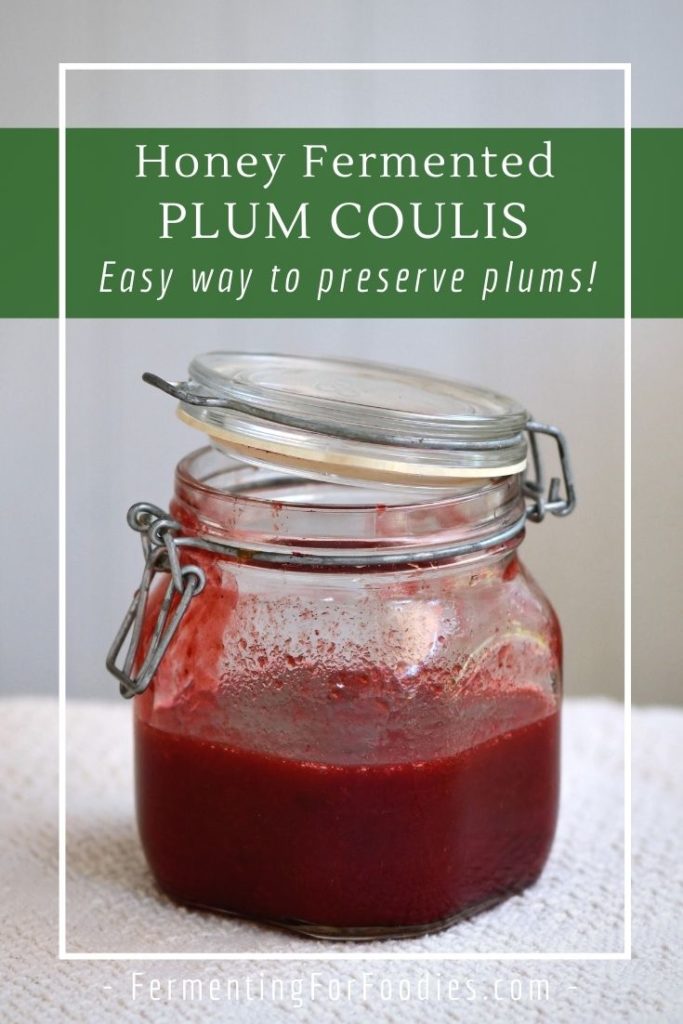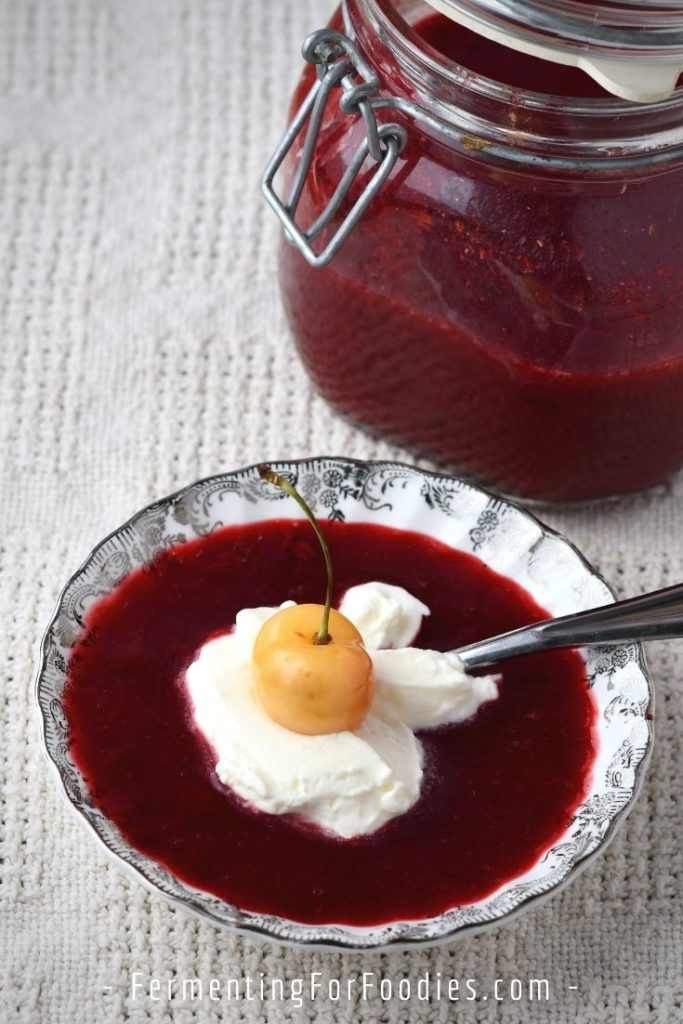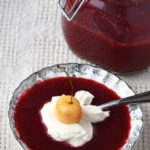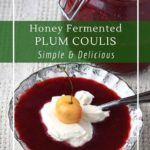
Looking for a simple way to preserve plums? This plum coulis is a simple honey-fermented recipe that skips all the cooking. It is a full-flavored sophisticated fruit sauce with a beautiful ruby red color.
To be honest, this coulis is actually quite sauce-like. However, plum sauce typically refers to a particular spiced Asian condiment so I’ve called it a coulis to distinguish it.
Honey Fermentation
Raw honey is a really reliable way to ferment foods. It naturally contains strains of yeast and bacteria that will readily ferment when mixed with water or fruit. (Think of mead). In this simple plum coulis recipe, the fermentation powers of raw honey are used to break down the plums and blend the flavors.
It means that this recipe doesn’t require any cooking! All you have to do is pack the plums into a jar and let the honey do all the work!
Options for finishing the plum coulis.
I’ve included a few different options for finishing the plum coulis in the recipe. However, I wanted to provide some more details.
- Thick coulis: Adding chia seeds is a simple and delicious way to thicken this coulis. Chia seeds are also high in fiber, so they are perfect for feeding your microbiome!
- Savory coulis: Though this is a honey ferment, it is not sweet. The yeast and bacteria do a pretty good job of eating up all the sugar. Without any additional sweetener, this coulis is a savory sauce perfect for serving with dinner.
- Sweet coulis: The coulis will continue to ferment until all the sugars are consumed. If you want to serve it as a sweet condiment, stir in more honey or sugar, right before serving.
- Berry coulis: This recipe doesn’t have to be made with plums. Feel free to swap out the plums for any soft fruit. Apricots, peaches, or berries will all make a deliciously simple fruit coulis.
- Clear coulis: The plum skins make this coulis a bit more rustic. For a clear, jelly-like sauce, press the finished ferment through a fine sieve or a food mill (affiliate link). If you want to thicken with chia, add it after straining out the pulp and skins.

How to serve plum coulis
This plum coulis is perfect for all sorts of savory or sweet serving options. Here are a few suggestions:
Savory Serving Options
- With cheese or part of a charcuterie
- To add a burst of flavor to chicken, pork, or fish
- A dip for barbecued tofu or tempeh.
- As an alternative to cranberry sauce at holidays
Sweet Serving Options
Plum coulis pairs nicely with creamy desserts. It adds a ton of brightness and flavor.
- A topping for ice cream
- Make a plum trifle
- Serve it with yogurt for a delicious snack
- A healthy breakfast topping for waffles or pancakes
Plum Coulis
This flavorful plum coulis is a sweet and savory sauce, perfect with dinner or dessert. Using the natural fermentation properties of raw honey means this simple coulis doesn’t require cooking. How easy is that!?
- Prep Time: 20 minutes
- Cook Time: 10 minutes
- Total Time: 30 minutes
- Yield: 1 pint jar 1x
- Category: Dessert
- Method: Fermented
- Cuisine: British
- Diet: Gluten Free
Ingredients
- 1 lbs plums (about 6 red plums)
- 3 whole cloves
- 1 star anise
- 1 pinch of ground nutmeg
- 4 Tbsp raw honey
- 2 Tbsp chia seeds (optional)
- 2 tsp vanilla extract
- 1 pinch of salt
Instructions
- Slice the plums in half and remove the pit. Dice them into bite-sized pieces.
- Place the spices and half of the plums into a pint-sized (1/2 L) jar for fermentation. Stir in the honey. If you want a thick coulis stir in the chia seeds as well. Add the rest of the plums and give everything a good stir to mix. The plums and honey should provide enough liquid to fully submerge the pulp.
- Cap the jar with a lid that will allow gas to escape (see notes). Place the jar in a cupboard and leave it to ferment for 3 to 5 days.
- After fermenting, stir in the vanilla extract and add the pinch of salt.
- Fermenting will make this coulis quite savory as most of the sugar will be consumed during the fermentation. If you want to serve it as a sweet coulis then add more honey (about 2 Tbsp) right before serving. (See the section above for more details on options for finishing and serving plum coulis).
- Store plum coulis in the fridge and use it within 1 month. Or freeze for longer storage. Plum coulis will be slightly carbonated for the first week after fermenting.
Notes
- To make fermented plum coulis, it is important to use pure raw honey. A lot of commercial honey is fake or adulterated. However, fermentation is not required. So if you can’t find raw honey, then simply use commercial honey and cook the coulis instead. To cook the coulis, bring it to a boil and simmer for 15 minutes until the plums are broken down.
- This ferment will bubble and build up pressure. Either cap with a screw lid that hasn’t been fully tightened or use a fermentation-specific lid, like a pickle pipe. Personally, I love fermenting in fido jars (affiliate links).
- Feel free to puree the coulis after fermenting. Remove the spices then pulse with a stick blender.





What type of wine was used??
I used a white wine (a gewurztraminer because it’s what I was drinking at the time. 🙂 ) But I think a red wine would be nice with red or purple plums.
Do you put a lid on while fermenting, or just cover with a cloth? Thanks!
You can’t ferment with a tight lid on. I usually use an airlock, or I use a plastic lid not tightened (to allow gas to escape).
What would you put in it or do to it to preserve it longer than a month in a jar
If you ferment for longer than a month it will be quite tart. If I wanted to leave it on a shelf for several months I would: sanitize my jar, use a proper fido, and be very clean in setting up the ferment. Usually, with sweet ferments, I freeze it for long-term storage. Then it’s still sweet when I’m ready to eat it!
This is good! So many variants!